The Best New York Style Pizza Dough and 14 Tips for Success!!
I’ve been making a lot of this NY style pizza dough recipe …. The obsession started a while back, and I’ve finally found a recipe that I love the best! After years of experiments (and I mean years!), I am now using this recipe based on recommendations from the many fine pizza makers at www.pizzamaking.com and the late great Dough Doctor, Tom Lehmann.

Making Pizza Dough at Home
Making NY style pizza dough is definitely somewhat of an art form. There are so many variables that can be changed aside from the ingredients alone. For example, these variables include:
- oven temperature
- temperature of the water used to make the dough
- proofing methods (room temp vs cold rise)
- order of adding the ingredients (yes, this makes a big difference!)
- mixing time
- use of autolyse
- use of poolish (I don’t do this or the one before, although I have in the past)
And then of course, the toppings which can be simple or as complex as you’d like. But don’t worry too much about all of this – my method is easy and straightforward. Plus, you will make better dough than 99% of the pizza chains out there. You will not want take out anymore!
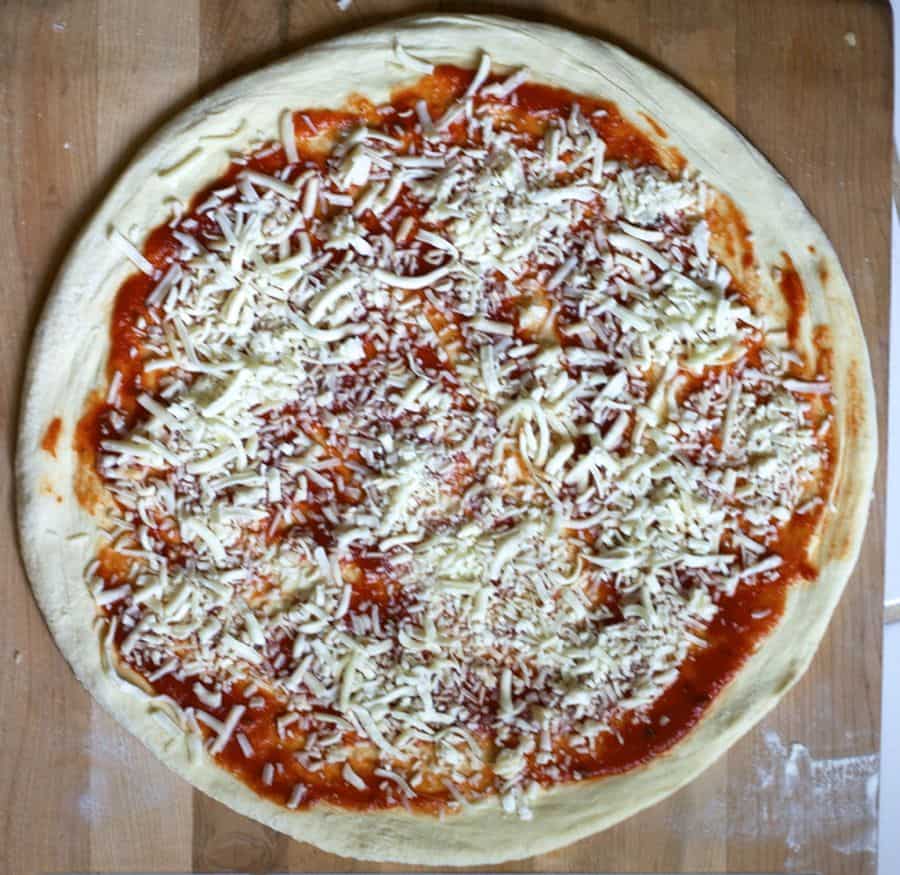
My Favorite Pizza Dough: The Big Secret (How You Proof the Dough)
My all-time favorite dough is NY style dough, which really is classic pizza dough that is stretched out into a thin crust pizza. This type of pizza dough contains water, flour, salt, instant yeast, and olive oil (and sugar especially when baking in a home oven, to help browning).
After it is mixed, it is proofed (left to rise/ferment) in the refrigerator for a minimum of 24 hours and up to 72 hours (it can also be frozen) – this is the big secret. I’ve used the dough up to 5 or 6 days afterwards, so you can essentially prepare dough for the week.
This recipe produces a crisp yet foldable crust that is tender, light, and flavorful and will make enough for four 14-inch pizzas. You can easily double or half the recipe to make 2 or 8 pizzas.

Fourteen Tips for Success
Tip 1: Choosing the flour
Use high-quality flour – I like to use King Arthur’s all purpose or bread flour; higher protein (ie, bread) flours work best. However, I prefer all-purpose flour because I like a lighter, airy crust.
Tip 2: Adding the yeast
Do not add instant dry yeast (IDY) directly to cold or cool water – you may shock the yeast (add the IDY to your flour instead) (please note that IDY differs from active dry yeast, which must be activated by adding it to water).
Tip 3: How much yeast?
Use only enough yeast to “get the job done” – yeast eats the sugar in your flour to produce its leavening effects – I find that if you use too much, your dough will be tasteless (this is just my opinion); however, it is a fact, that too much yeast can make your dough taste bad. Most recipes out there, some of them in well known, published books contain too much yeast!
Tip 4: Cold ferment that pizza dough!
Always use your refrigerator. The best NY style doughs “ferment” or “cure” in the refrigerator for at least 24 hours and up to 48 72 hours. This is called a “cold rise” (vs warm rise on your kitchen counter).
The refrigerator is used to retard (or slow) the dough’s fermentation, allowing that distinctive flavor to come through (ever wonder why some pizza crust tastes different than others, despite the fact that they are both made from just about the same exact ingredients? – this is a big reason why!)
When your dough rises too quickly, the flavor will not develop optimally. Slow rise = MUCH better flavor.
Tip 5: Weigh those ingredients!
Use a scale to weigh the flour instead of using a measuring cup – it is much more accurate and will yield superior results. I’ll admit, I resisted doing this for a loooong time. Just do it. You’ll be glad you did and your dough will be more consistent and much improved.
Tip 6: Add oil last
Mix the oil in as the last step, after the flour has all been incorporated. This is important to allow the flour to hydrate properly.
Tip 7: Flour your dough balls
Before tossing or opening your dough balls, flour them *very* well on each side (if you are a beginner) to ensure they do not stick to your counter or pizza peel. I sometimes use a bit more flour after I begin spreading them.
Tip 8: Keeping those rims a bit puffy
Take care not to “degas” the rim of your pizza as you are spreading your dough! Do NOT ever use a rolling pin! There are many different methods to spread/open your dough ball. I hope to add a few pictures someday of this process.
Tip 9: Baking pizza in a home oven
Ensure that your oven is preheated for a sufficient amount of time (about 1 hour) and bake the pizza within 6 to 8 inches of the top of your oven (ie, your broiler) so that the tops browns sufficiently in conjunction with the bottom of the pizza.
Do not place the stone near the bottom of your oven. I made this mistake for too many years.
After your stone has been preheated sufficiently, the heat from the stone will cook the pizza from the bottom and you can switch the broiler on if you find you need more browning on the top (I now use the broiler to bake my pizzas…more on this sometime in the future).
If you find that your cheese is browning well before your rim attains sufficient color, use partially frozen cheese (ie, place shredded cheese in the freezer while the oven is heating up) and cold sauce or you can drizzle just a bit of olive oil on top of cheese.
Tip 10: Use a pizza stone or steel
Use a pizza stone if you have one. The stone with draw moisture out of the dough and produce a beautifully crisp crust. I use a pizza steel because my stones kept breaking.
Tip 11: Use just the right amount of sauce
Do not use too much pizza sauce – it will make your pizza soggy
Tip 12: Find the right kind of cheese
Do not use low fat cheese to top your pizza or pre-shredded cheese (the former will not melt sufficiently and the latter contains additives that prevent the cheese from sticking together and therefore does not melt very well). The best is low-moisture, whole milk mozzarella.
If you must use pre-shredded cheese, I’ve found that adding the sauce on top of the cheese helps with the melting. Also, do not use too much cheese; apply it sparingly so that you can achieve that mottled NY pizza appearance.
Tip 13: Flour your pizza peel
Use semolina or flour on the bottom of your pizza peel to prevent the pizza dough from sticking but be careful not to overdo it because it will burn.
Tip 14: Learn to launch that pizza
Give the pizza peel a few very small quick jerks to make sure the pizza will easily slide off your pizza peel before attempting to transfer pizza to the oven, and more importantly, rub flour into the peel before placing the dough on top.
Essential Equipment
Please note that as an Amazon affiliate, we earn a small commission if you purchase a product at no additional cost to you.
I adore my baking steel; it’s transformed my home pizzas into restaurant-quality and better. You will love this! A kitchen scale streamlines measurement with remarkable accuracy, while a pizza peel is essential for smoothly sliding pizzas into the oven. And proofing boxes provide an optimal storage for pizza dough fermentation, enhancing flavor, texture, and elasticity.
Please visit our SHOP page for more recommended tools and equipment to make restaurant-style NY-style pizza at home!
How to Stretch the Pizza Dough
A nice video (from The GoodFellas Pizza School of NY), showing how to stretch the dough:

How to Freeze Homemade Pizza Dough
- After mixing dough and dividing into balls, place dough in refrigerator for at least 24 hours.
- Place dough balls on baking sheet lined with plastic wrap or parchment paper, cover loosely with plastic wrap and freeze until firm (~ 2 to 3 hours or up to overnight).
- Wrap frozen dough balls individually in plastic and store in zipper-lock bags for up to 4 weeks.
- When ready to bake, transfer unwrapped dough into the refrigerator for 12 to 24 hours before making pizza.
- Bring dough to room temperature for 20 to 60 minutes before baking (less time for hot kitchen/summer and more time for cool kitchen)
Pizza Dough Calculator
Need more dough? Less dough? Try out our new Pizza Dough Calculator to calculate the weights to get it just right!
Have More Questions?
Please See My NY Pizza FAQ
If you tried this recipe, please leave a 🌟 star rating and let me know how it went in the 📝 comments below! SUBSCRIBE for more recipes.
📖 Recipe

The Best New York Style Pizza Dough
Equipment
- pizza stone or pizza steel for baking
- Standing mixer optional or hand knead
- kitchen scale highly recommended instead of volume measures
Ingredients
Original Recipe for Four 14-Inch Pizzas; want to make more or less? Use the pizza dough calculator
- 6.5 cups (796 g) all purpose flour or bread flour (weighing is most accurate!)
- 2 1/4 cups (493 g) water barely cold water (17.4 oz per 2 1/4 cups)
- 1 teaspoon (3.5 g) instant dry yeast
- 2.5 teaspoons (15.6 g) salt
- 2 teaspoons (7.8 g) sugar
- 1 tablespoon (11.8 g) olive oil
1 Pound of Dough (~454 grams) (use the pizza dough calculator to make more or less dough)
- 2 1/4 cups (274.5 g) all purpose flour or bread flour
- 3/4 cup (170.2 g) water
- 1/2 teaspoon instant dry yeast
- 1 teaspoon salt
- 3/4 teaspoon sugar
- 1 teaspoon olive oil
Instructions
Mixing the Dough
- Place water in mixing bowl.
- In a separate bowl, mix salt and yeast (and sugar if using) into flour
- Combine flour/salt/yeast mixture into water and mix until all the flour has been incorporated.
- After flour has been totally incorporated, add oil and knead for about 4 to 5 minutes (see note)
- Test final dough temperature, which should ideally be between high 70s to low 80s (optional)
Dividing and Rising
- Divide dough into 4 equal pieces (using a digital scale if possible; each ball should weigh 11.5 oz [~326 grams]), shape into a ball, and place in greased, sealed quart-sized container or oiled/greased freezer bag and refrigerate overnight or up to 72 hours (After much experimenting, I have concluded that I like 3 days best but day 2 is good too).
Assembly and Baking
- The following day, remove your dough balls within 1 hour or less of baking and allow the dough to come to room temperature. (the dough will tend to blister more if the dough has not been allowed to come to room temperature however, I often bake coldish dough without problems, just some bubbling)
- In the meantime, place your pizza stone in oven and preheat at 550 degrees (depending on thickness of your stone and your oven’s power) for at least 1 hour
- Open each dough ball using care not to degas, transfer to a pre-floured pizza peel (or on parchment paper), and top with your favorite sauce, cheese, or other toppings.
- Transfer pizza from peel to oven or slide parchment paper onto preheated pizza pan/stone and bake for 4 to 6 minutes each until browned on top and cheese has melted but not burned.
- Enjoy!
Notes
- Use of weight based measurements is highly recommended instead of US Customary. You will need a kitchen scale.
- METRIC amounts DO NOT correspond exactly to the US Customary amounts because, for example, 796 grams equals 6.4 cups (and most can’t measure 0.4 cups or 0.22 cups). Recipe was based on grams.
- Use the Pizza Dough Calculator
- If you want to use the dough the next day, knead a little more (slow speed for about 8 to 10 minutes)
- If you have time to let the dough rest for 3 days, knead for 4 to 5 minutes, low speed or hand knead.
- After mixing dough and dividing into balls, place dough in refrigerator for at least 24 hours.
- Then, place on baking sheet lined with plastic wrap or parchment paper, cover loosely with plastic wrap and freeze until firm (~ 2 to 3 hours or up to overnight).
- Wrap frozen dough balls individually in plastic and store in zipper-lock bags to store for up to 4 weeks (longer may work, but results might vary).
- Before using, transfer unwrapped dough into the refrigerator for 12 to 24 hours before making pizza.
- Bring dough to room temperature for 20 to 60 minutes before baking (less time for hot kitchen/summer and more time for cool kitchen).
- calculate your own using baker’s percentages: 62% hydration, 0.4% yeast, 2% salt, 1.5% oil, and 1% sugar or use my new pizza dough calculator.
Nutrition
Try these other pizzas and this NY pizza sauce:
Buffalo style (one of my absolute favorites)
White with prosciutto
White with spinach and feta
Pizza sauce

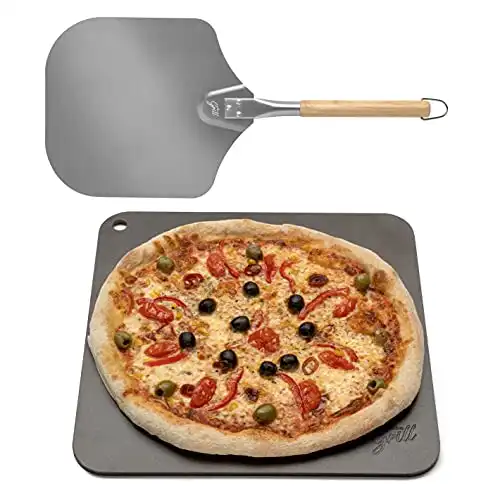
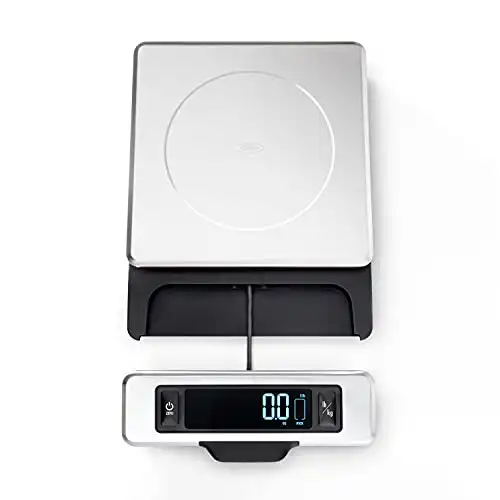
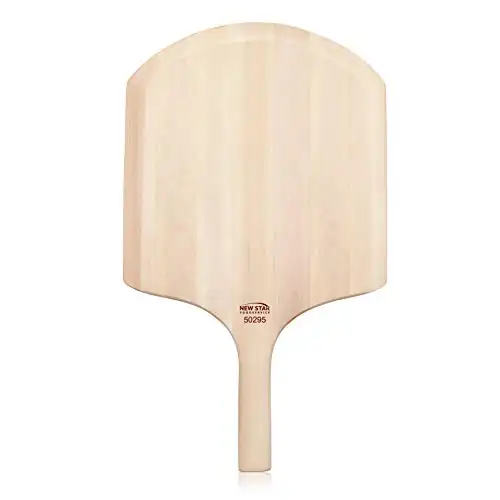
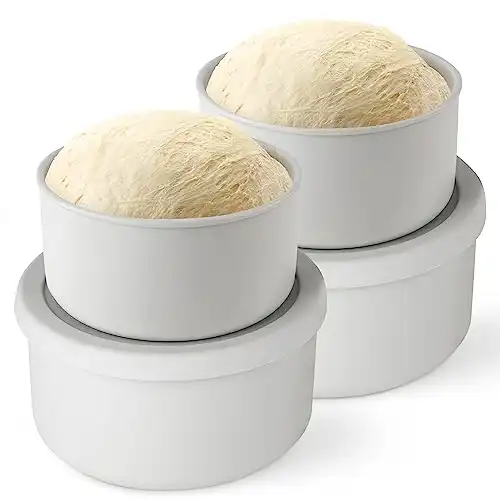
Made this recipe, let it cold ferment for two days and the crust was fantastic! Moved to KY two years ago and could not get a decent pizza crust to save my life. One question, just how sticky should the dough be? The dough looked a little wet to me after 2 days in the fridge, I used a scale to measure everything but wondering if I should have used a tad more flour. Going to make another batch today it was that good!
A little sticky is fine – flour the dough. ball’s very well on each side before you start to press into pizza shape…and enjoy:)
I have fallen in love with this recipe! Amazing pizza with not a lot of effort. Plus the links and tips for making the pizza without it degassing make the crust beautiful and delicious!
I used active dry yeast and made a half batch split into two balls. We had our first one (2 day rise) last night and it was great! Chewy, thin and very much the NYC style I love. I made a spicy sauce and let it sit overnight as well. About to make the second pizza with the 3 day cold rise today. I doubt we will be ordering pizza anytime soon.
It was my first time making homemade pizza and I followed this recipe to a T. I even followed the video for stretching the dough. It was PERFECT! The dough was thin with a nice bubbly crust. I can’t wait to make it again!
😀😀😀👏👏👏👍🏼👍🏼👍🏼👍🏼
Hi, is it supposed to be sticky? I used extra EVOO to form a ball before cold proofing it. Thanks.
Yes the pizza dough is sticky…sounds like you’re on track
I’m a Brooklynite, born and bred, and have been making this recipe for years in the name of frugality. Always loved it, as does my husband and 6 kids. Glad to see you’re getting a ton of fresh hits now that people are on lockdown.
I have made this dough 6x now and I absolutely love it. I don’t use a stone but a pizza pan baking sheet and it turns out perfect every time. Personally my family has liked getting 3 – 1lb portions of dough instead of 4 smaller ones. It is still thin but it actually fits the size of my pizza pan. I couldn’t master it with the 4 portions. My question is, since we need to have this on hand all the time now, I was wondering if I could freeze the dough. Should I keep it in the fridge for a couple of days first or can I immediately freeze it after I make it. Any advice would be helpful! Thank you for this great recipe that my entire family loves!
Hi Michelle, glad you like it! Over the years I’ve frozen leftover dough here and there. although you can place directly into freezer after mixing the better method is to let it rise first for at least a day before freezing.
Once we have waited the 24-72 hour mark, how long can we freeze the dough for? Before using it to cook?
Opinions range a lot here…standard response is usually 30 days but I’ve used older dough. I’d recommend wrapping individual dough balls (sized for pizza) in plastic wrap and then placing into a freezer bag
Thank you for this Marie! I have a few questions.
1. Is it OK to refrigerate a few hours before making instead of a day before? (For those spontaneous “I want pizza today” moments?
2. I don’t have olive oil can I use vegetable oil?
3. Can I make this in the bread machine?
Thank you!
Hi Miriam, I’ve never used a bread machine before so I’m afraid I can’t help you on that one. Vegetable oil is fine and if you want to try and make dough the same day, I’d suggest making the dough about 6 hours ahead of tome and let it rise at room temperature (provided it’s not too hot or cold in the kitchen, ~70 degrees Fahrenheit). The overnight cold proofing does give it that special flavor so make sure to try both.
Is there any different using dry active yeast instead of instant? Should I make any changes to the amounts?
I use them interchangeably (1:1 substitution) in this particular recipe, although some say you need 1.25 teaspoons of active dry yeast for every 1 teaspoon of instant yeast
It seems like your cups measurement for flour are incorrect. It says 6 cups but it should be 3 1/2 cups. The fluid ounces and grams seem to be okay. I was using the cup measurement for the recipe and couldn’t figure out why the dough was so dry. I re-read the recipe and was thinking wait… this isn’t 62% hydration… I’m not sure if this recipe was edited, but seeing the high reviews and positive comments led me to be overly excited and not really double check before kneading the dough and putting in the fridge. I was able to knead in an additional cup or so of water before putting in the fridge to cold ferment, but I have low expectations it’s enough hydration to keep the yeast alive.
I’m sorry I’m not following you Bill. How many grams of flour per 1/4 cup on your labeling? The error is not mine – maybe you should remeasure…3 cups of my flour is 360 grams added to 490 grams of water and you have a batter not a dough.
My friend cooked this recipe for me years ago and LOVED. Now I’ve been doing it for my family for weeks since we started isolation and we won’t be ordering pizza anytime soon 🙂 I just have a couple of questions. I measure the flour and all but my dough needs a little more water? Not sure if that has to be with the fact that I don’t have a machine to mix it… Something that I noticed also is when I add the olive oil at the end the dough doesn’t rise as much as when I mix the oil in the water? I also find the dough easier to work if I mix oil and water first… I might be changing your entire recipe doing these changes but even doing like that the results are amazing!!
I think that’s fine:) the most important part is a long slow rise. And good flour of course
Bill, Mary measurements are fine. it seems like you packed the flour into the cup. Never scoop the flour with a cup, Flour needs to be fluffy not packed. The best way to measure ingredients for baking is to use a baking scale. Happy Baking and Pizza dough making!
Great Pizza dough recipe! One suggestion use a baking scale instead of a cup for measurement. Some people use the cup to scoop the flour and some people pack the flour into the cup.
Hi, thanks for this recipe. I am excite to try it out and have already put the dough in the fridge for over 24h.
My question is, what should we do if we don’t have a baking stone? If I put it in a pan, should I still preheat oven at 550 degrees and how long should I leave the pizza in for?
Thanks in advance!
When I first started baking I would use a cookie sheet for a stone (flip it upside down if it has a lip so the top is flat) and then spread dough on another flat cookie sheet (flip upside down if you have to) and slide the dough to the “pizza stone” after your oven warms up….I hope that makes sense. You can also use parchment paper to help transfer the dough if that helps. Oh and still use same temp for oven and check to see if brown underneath if not bake a few mins longer
Hi, Bill is right- your recipe says “6 Cups” of flour, followed by 28 oz for measurement. 8 oz = 1 cup. It should read 3.5 cups of flour.
No, you and Bill are both incorrect. A cup of liquid water is 8 fluid ounces but a cup of popcorn or chocolate chips or flour will not weigh 8 ounces. You are mixing up volume and mass measurements.
Great recipe ! I’ve made it a few times and it’s been really good. I have run out of instant yeast and none is to be found in the grocery store however I found fresh yeast. How many grams of fresh yeast would I use ?
The rule for substituting fresh yeast is three times the amount of dried yeast. I’ve never seen fresh yeast in the stores- great find!
Thanks ! Do I have to activate the fresh yeast or can I follow your directions ?
Yes use this info for more details
I made pizza with this dough today (made the dough 2 days ago and just baked 2 pizzas for dinner tonight). Amazing! Family loved it! I was worried I didn’t do it right since I used active dry yeast instead of instant yeast and I didn’t activate my yeast. I also saw other recipes use much more yeast to flour, I even commented to make sure the amount of yeast wasn’t a typo. This crust turned out great. Thank you for this recipe. Will definitely make it again!
I made this and the only issue was my oven only goes to 500. I think the bottom didn’t brown because the stone could not get hot enough. But the recipe is awesome! Thank you!!
Representative of a Long long looooong line of pizza snob manhattanites here….and this is SPOT ON! Whoever didn’t give this 5 stars doesn’t know what NYC pizza is. Like this time I saw a guy give back a fresh Maine lobster because it didn’t taste like what he was used to…and when the waiter inquired where he was from…”Wisconsin”. Hahaha! =Red lobster, this guys used to, returning a fresh caught. Anyway…like that. This is the perfect NYC dough. 5 stars all day!
We had it tonight…quarantined family dinner. Everyone was flipping out. Now if I can only get the F-EN sauce right I’ll be golden! I’m damn close. People thought it was exactly like NYC but it was just a little not right in the sauce. Almost!!! But the dough….perfect! Thanks Marie!
Followed the instructions exactly and it turned out great! Foldable, yummy , even on day 6